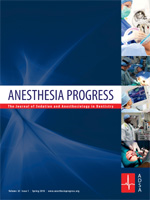
Anesthesia Progress volume 67 issue 1
Of particular note was the splatter found behind the face shield and underneath the chin of the anesthesiologist, illustrating just how impactful a cough can be at releasing the SARS-CoV-2 virus.
LAWRENCE, Kan. (PRWEB)
June 23, 2020
Anesthesia Progress—Receiving dental care during the COVID-19 pandemic has been extremely challenging for patients and providers alike. The virus, which is primarily found in oral, nasal, and pharyngeal mucosa and in pulmonary secretions, is an air-borne contaminant and spreads through respiratory droplets, contact contamination, or by aerosols produced during aerosol-generating procedures (AGPs). Given the transmission type, four of the top five professions at the highest risk for the contracting the virus are within the dental field. It is of the upmost importance that appropriate protective measures are put into place before routine dental care can resume as normal.
Researchers from the University of Toronto, University of Vancouver, and private practice in British Columbia published a study in the current issue of Anesthesia Progress that examined the extent of splatter produced during an AGP or coughing while receiving dental care.
To simulate a dental procedure and examine the extent of splatter, the researchers used a dental mannequin fitted with a set of model teeth coated in Glo Germ™, which appears blue under an ultraviolet (UV) light. While wearing short-sleeved scrubs, goggles, a surgical mask, and gloves, a dentist and dental hygienist performed three different dental procedures on the mannequin using a high-speed handpiece, an ultrasonic scaler, and an air-water syringe; all three were done with continuous use of high-volume suction. To simulate a cough during a procedure, a ventilator was equipped with and programmed to release Glo Germ™ during the procedure. During this simulation a dentist anesthesiologist was introduced wearing the same personal protective equipment (PPE) as the dentist and hygienist, with the addition of a face shield. After each procedure or cough, the participants were taken to a dark room where UV light was used to examine splatter patterns and photographs were taken and analyzed to document the extent of the splatter.
The researchers found that after each AGP was performed, both the dentist and hygienist had splatter on their face, body, arms, and legs. The simulated cough showed an increased amount of splatter produced, and, in addition to their face, body, arms, and legs, the dentist and hygienist had splatter on the crown of their head, back, and shoes. The anesthesiologist had a significant amount of splatter on every surface of the body, except for the back and shoes. Of particular note was the splatter found behind the face shield and underneath the chin of the anesthesiologist, illustrating just how impactful a cough can be at releasing the SARS-CoV-2 virus.
The researchers conclude that in addition to eye protection, masks, and gloves, dental professionals should also wear face shields, bouffant/surgical caps, and shoe coverings to fully protect themselves from the virus. This full set of PPE should also be changed between patients to avoid cross-contamination of the patients or staff during procedures that generate AGPs.
Full text of the article, “Aerosol Generating Procedures and Simulated Cough in Dental Anesthesia,” Anesthesia Progress, is now available here.
###
About Anesthesia Progress
Anesthesia Progress is the official publication of the American Dental Society of Anesthesiology (ADSA). The quarterly journal is dedicated to providing a better understanding of the advances being made in the science of pain and anxiety control in dentistry. The journal invites submissions of review articles, reports on clinical techniques, case reports, and conference summaries. To learn more about the ADSA, visit: http://www.adsahome.org/.
Share article on social media or email:

